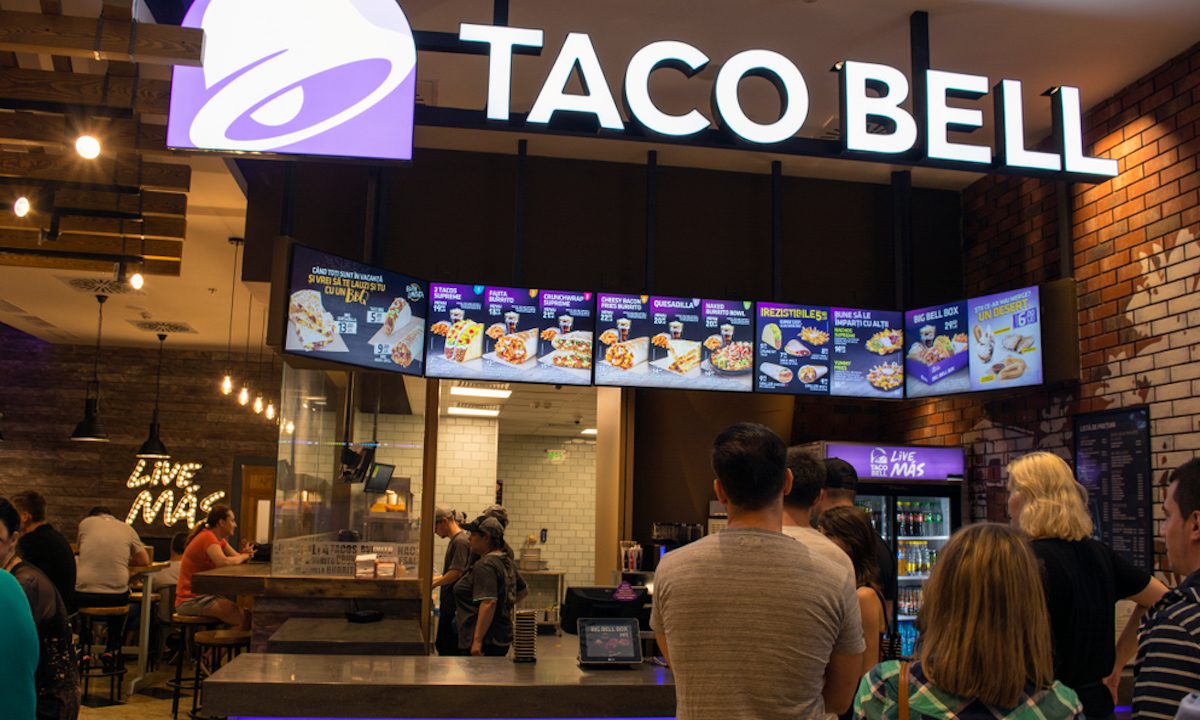Taco Bell Restaurants Will Keep Getting Smaller, Says COO

The way that consumers interact with restaurants has changed enormously in the last year and a half, and restaurants that do not adapt to the “new normal” risk falling behind. Certainly, this entails adopting the digital platforms that have become table stakes — offering mobile and web ordering platforms that are easy to access and easy to use, for instance — but leading restaurants are not limiting their transformation to cyberspace. After all, the physical restaurant as we know it was not designed for the omnichannel experience.
Taco Bell, for one, has been getting playful. The chain has been trying out a number of creative new restaurant designs. In the spring, the company opened a fully digital store in the middle of New York’s Times Square, offering a self-guided experience with ordering kiosks and pickup cubbies. Earlier this month, the chain revealed its Defy restaurant design, a four-lane mobile-integrated drive-thru where orders are sent down from the kitchen through a food elevator.
“The 3,000-square-foot, two-story model … has a smaller or equal footprint compared to existing store footprints and will be able to serve even more customers,” Taco Bell President and Chief Operating Officer Mike Grams told PYMNTS in an interview.
Read more: With New Drive-Thru Concept, Taco Bell Doubles The Double Lane
Related news: Taco Bell’s New Times Square Store Has Digital Focus, Dedicated Pickup Area
Full Speed Ahead
Drive-thru is more popular than ever. A Google Trends analysis finds that searches for “drive-thru near me” began rising in March 2020, peaking in early December. Now, consumers continue to search for drive-thru options in their area more than 20 times more often than they did in August of 2019. Restaurants that can offer a quick and convenient drive-thru experience have the opportunity to capture this surge in demand.
“Speed is everything when it comes to the drive-thru,” said Grams. “When it comes to Taco Bell Defy, we’re especially excited to hear consumers’ reactions to the contactless lift system that delivers food from the upstairs kitchen to cars in about six seconds.”
In a 2020 study by SeeLevel HX, Taco Bell came in second out of 10 quick-service restaurant (QSR) chains for speed, though it fared less well in categories such as accuracy and customer service. The chain cut its drive-thru time by nine seconds in 2020, even as the industry average rose 30 seconds.
Additionally, PYMNTS research featured in the May edition of the Order to Eat report created in collaboration with Paytronix found that more than one in four already vaccinated restaurant customers would be encouraged to spend more on their food orders if the restaurant offered drive-thru pickup.
Related news: The Key Features That Helped Clean Juice Keep Sales Flowing
Upwardly Mobile
Grams noted that the chain is especially proud of its Go Mobile concept, a restaurant design that the chain launched one year ago, which features a footprint of 1,325 square feet (just over half the average for one of the chain’s restaurants). The concept was something of a precursor to Defy in that it introduced the mobile order-ahead drive-thru lane for Taco Bell app users. The model also features a pickup area for mobile curbside orders.
“Since its launch, our focus on the drive-thru experience has allowed for incredible headway with Go Mobile,” said Grams. “We already have 13 built and 85 in the pipeline, with those currently open performing very well.”
PYMNTS’ latest ranking of major restaurant chains’ mobile ordering apps finds that the chain has the fourth best app out of 77 leading players in the space, ranking just below Domino’s, Starbucks and Dunkin’, just above Panera Bread, Chick-fil-A and Wingstop.
You may also like: PYMNTS’ Mobile Order-Ahead (MOA) Ranking
The increasing integration between the mobile ordering tools and the physical restaurant goes a long way toward providing a compelling omnichannel experience. “There are many factors that come into play when planning for each and every new build and remodel,” Grams told PYMNTS in a previous interview. “The current needs of our guests will continue to evolve, as will technology — often rapidly and unexpectedly.”
See also: Taco Bell President: ‘Restaurants Of The Future’ Will Tap Targeted Experiences
Big Swings, Small Footprints
Many restaurants are rethinking the ways they use their physical spaces to reflect changes in the industry. Burger King recently opened its first location with its new “Pavilion” retro-style design to appeal to consumers’ sense of nostalgia, P.F. Chang’s announced new smaller format To Go locations that do not offer on-premise dining, Jack in the Box recently revealed its drive-thru-only prototype and Wendy’s is going all-in on ghost kitchens, with plans to open 700 delivery-only locations by 2025.
Read more: Redesigns Bring Restaurants Into The 2020s
Also see: Wendy’s To Open 700 Delivery-Only Locations In The Next Five Years
Still, even in the midst of all this industry-wide innovation, Taco Bell stands out for the bold moves it has made in recent months.
“So much has changed in even the past two years, [and] it’s exciting to think of what can continue to evolve,” said Grams. “As we look ahead, we’re excited by the challenge to reduce our restaurant footprint in concepts of the future, to better cater to our customers’ evolving needs.”

